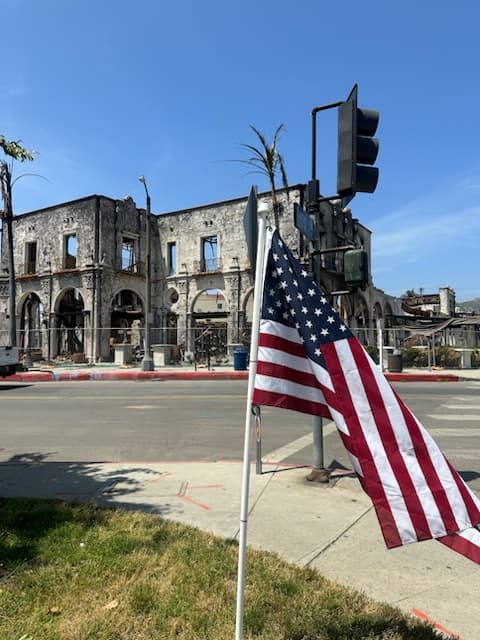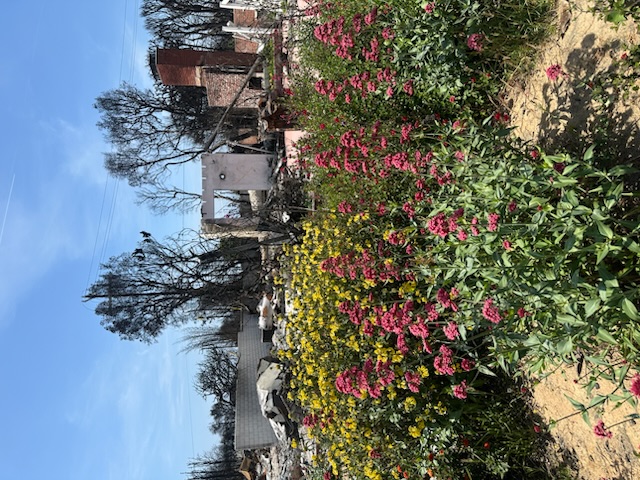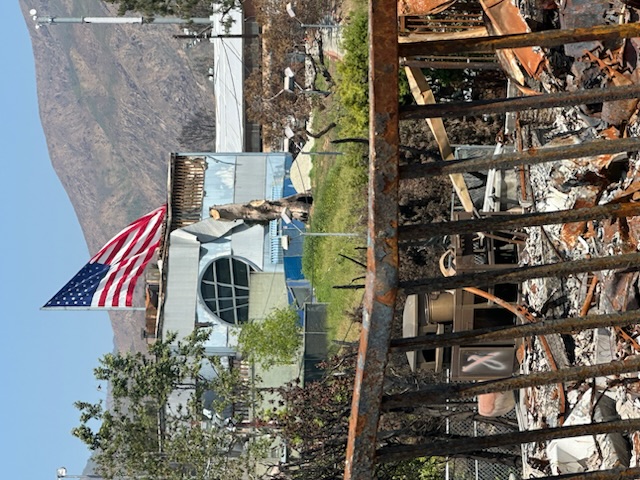
Another Californian Fire Bombed Town
It still looks like a bombed out town. A place that has been through a war.
American flags flap over twisted metal and blown out blocks of concrete with peeling paint. Row after row of dirt rectangles that were once covered with stylish homes and designer gardens. Going back feels like identifying the body of a dead relative, you recognize everything and nothing. It’s like a bad dream you want to wake up from. Better to remember the town when we all walked everywhere in flip flops, and ate at Cafe Vida, and complained about how crowded the town was becoming. There was never a day when you didn’t run into people you knew. Now the streets are mostly empty, except for construction workers and out of town investors who drive in to size up the empty lots.

The eeriest part is the way the fire left some streets untouched, while ravishing others to dust and debris. The area I grew up in behind Pali High did pretty well. The majority of houses are still standing, except for the block where my childhood home use to be. There, everything is gone: houses, trees, children’s play equipment. The wildflowers came back in the Spring. My mother’s native garden bloomed against the backdrop of a lone brick chimney rising out of the empty lot. The October leaves were rustling again, on the trees that hadn’t been burned, but there was no sounds of children crinkling candy wrappers this Halloween. Sometimes you hear construction, sometimes it’s very quiet. It’s been almost a year, and the smell of the ocean has blown away the smell of smoke, but the rooms filled with the scents of candles and family dinners are still a memory, hovering over a dusty space that “has been cleared.”

A statistic for LA politicians to brag about, “Our recovery effort is on track to be the fastest in modern California history,” says Mayor Bass. Our recovery… This column will begin by chronically the Pacific Palisades recovery. What is happening, and where we go from here. Residents in various stages of rebuilding, and what the city and the county of Los Angeles are doing to make easier or harder for families to return.

Both my parents’ and grandmother’s home burned down on January, 8th. My parents’ house is at least relatively simple to rebuild, and they are determined to do so. My father is an immigrant who came to America when he was seventeen. My parents bought the home in the Palisades a year after they were married; their first and forever home. My grandmother’s home is more complicated. It’s in a part of the Palisades that sits on a hill side and uses septic tanks. The city is currently requiring residents to replace the septic tanks and pay for expensive geological studies of the hillside, which means it will cost tens of thousands of dollars before the rebuilding process even begins. My grandmother, who came from Arkansas after the Great Depression, sacrificed for years to hold onto the house through a difficult divorce, determined to pass it on to my mother and uncle. The way things stand now, they may be forced to sell.
The fire is a lesson in how fleeting and unpredictable life is. When wedding rings, and family heirlooms, a lifetime of letters and handmade Christmas ornaments burns away, it’s suddenly very real, that in the end we really will have to let it all go. When the most beautiful neighborhood in the city can burn to ash in a few days, anything and everything can be lost. But it is also true that every end marks a new beginning. The question for so many of us is: out of the ash, what Phoenix will arise? This is the story of our recovery.


